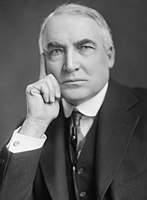| ||||||||||||||||||||||||||
| ||||||||||||||||||||||||||
 County Results
Harding 50–60% 60–70% 70–80%
| ||||||||||||||||||||||||||
| ||||||||||||||||||||||||||
| Elections in Idaho |
|---|
 |
The 1920 United States presidential election in Idaho took place on November 2, 1920, as part of the 1920 United States presidential election. State voters chose four representatives, or electors, to the Electoral College, who voted for president and vice president.
At state level, Idaho had begun in 1902 to be very much a one-party Republican state,[1] which it has largely remained since apart from the New Deal era of the 1930s and 1940s. For a time there was also a perception that the William Jennings Bryan-led Democratic Party had failed as a “party of reform”.[2]
However, with the aid of a powerful “peace vote” due to opposition to participation in World War I,[3] and a considerable part of the substantial vote for Eugene Debs,[4] Woodrow Wilson almost completely swept the Western and Plains States in 1916, losing only South Dakota and Oregon.
However, the Democratic Party's gains in the West were not to last. By the beginning of 1920 skyrocketing inflation and Wilson's focus upon his proposed League of Nations at the expense of domestic policy had helped make the incumbent president very unpopular[5] – besides which Wilson also had major health problems that had left First Lady Edith effectively running the nation. Political unrest seen in the Palmer Raids and the "Red Scare" further added to the unpopularity of the Democratic Party, since this global political turmoil produced considerable fear of alien revolutionaries invading the country.[6] Demand in the West for exclusion of Asian immigrants became even stronger than before.[7]
With the very strong interior isolationist and anti-League of Nations sentiment of Northern and Central Idaho,[8] and local senator William Borah saying that all wars should be subject to a referendum in September,[9] it was apparent that Idaho would swing very strongly against the pro-League Cox, especially as the extremely independent Borah endorsed Harding on October 3.[10] Cox did make a brief visit to the state in mid-September,[11] The state's opposition to Cox's platform became further apparent when on October 24 the Democratic nominee said he did not accept that Congress should be able to veto presidential calls for war against foreign countries.[12]
As early as the end of August, Harding campaign strategists led by Washington State Senator Miles Poindexter were saying Cox's pro-League policies would lose him the West.[13] a straw poll at the beginning of October vindicated Poindexter: Harding led Cox in Idaho by slightly less than a two-to-one margin.[14] At the end of October, Idaho was described as “absolutely certain” for Harding,[15] and such polls reflected the result. Whereas internationalist GOP nominee Charles Evans Hughes won just five counties in 1916, Harding carried every Idaho county by double digits.
- ^ Burnham, Walter Dean; ‘The System of 1896’, in Kleppner, Paul (editor), The Evolution of American Electoral Systems, pp. 176-179 ISBN 0313213798
- ^ Robinson, Edgar Eugene; ‘The Decline of the Democratic Party’; American Journal of Sociology, vol. 20, no. 3 (November 1914), pp. 313-334
- ^ Menendez, Albert J.; The Geography of Presidential Elections in the United States, 1868-2004, p. 47 ISBN 0786422173
- ^ Sarasohn, David; 'The Election of 1916: Realigning the Rockies', Western Historical Quarterly, Vol. 11, No. 3 (July 1980), pp. 285-305
- ^ Goldberg, David Joseph; Discontented America: The United States in the 1920s, p. 44 ISBN 0801860059
- ^ Leuchtenburg, William E.; The Perils of Prosperity, 1914-1932, p. 75 ISBN 0226473724
- ^ Vought, Hans P. ; The Bully Pulpit and the Melting Pot: American Presidents And The Immigrant, 1897-1933, p. 167 ISBN 0865548870
- ^ Phillips, Kevin P.; The Emerging Republican Majority, p. 498 ISBN 9780691163246
- ^ ‘War referendum Urged by Borah: Idaho Senator Says No Other Peace Scheme is Worthy of People's Confidence’; The Washington Post, September 15, 1920, p. 1
- ^ ‘Borah Spurns All Linking of Nations, but Is for Harding: Says There Is No Alternative to Voting for the Republican Nominee’; Special to the New York Times, October 5, 1920, p. 1
- ^ ‘Cox Now Charges $30,000,000 Is Goal: Declares Opponents Seek That Enormous Fund to Beat Him’; Special to the New York Times, September 14, 1920, p. 1
- ^ ‘Cox Would Take Reservation to Article X – No Obligation to Use Military Force Unless Congress approves in Each Case’; New York Times, October 24, 1920, p. 1
- ^ ‘Claims west for Harding: Poindexter Says Cox’s Wilsonian Policy Will Not Win Votes There’; Special to the New York Times, August 27, 1920, p. 1
- ^ ‘Harding Leads in the Straw Vote: Cox Weak in North and West in Rexall Balloting’; Boston Daily Globe, October 3, 1920, p. 10
- ^ ‘Harding 33 Sure, Cox 114, Is Prediction: John T. Adams of G. O. P. Committee Estimates Result of Electionm Lists Doubtful Votes. Republican Nominee, He Says, Will Capture at Least 380 in Total’; San Francisco Chronicle, October 31, 1920, p. F4

